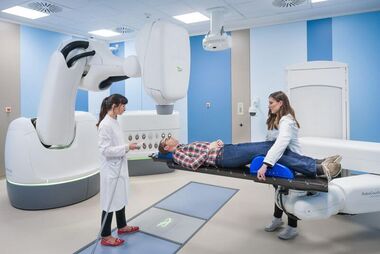Destroy tumors, protect healthy tissue:
Inauguration of the new "Cyberknife" Heidelberg, high precision radiation therapy unique worldwide

October 2016
With the inauguration of the cyberknife, Heidelberg becomes the only center worldwide to offer all currently available high-precision radiation therapy techniques. The new radiosurgery “cyberknife” system enables high precision radiotherapy for cancer patients without general anesthesia or rigid restraint. Radiotherapy can be performed from a multitude of angles and automatically compensates for respiratory movements. Approximately 100 patients have been treated already with the "cyberknife".
On 14 October 2016, the Department of Radiation Oncology at Heidelberg University Hospital celebrated the inauguration of the new cyberknife with a specialist symposium. Using a mobile robot arm, the radiosurgical system can precisely target tumors for radiation from various angles. This accelerator device is currently the most accurate worldwide. Two integrated x-ray devices continuously supply position data, so that the cyberknife can monitor both patient and tumor independently, and compensate for respiratory movement. This enables radiation accuracy to the sub-millimeter level without anesthesia or patient restraints, optimally protecting the surrounding tissue. The first patients, for example those with inoperative brain or bone metastases, have already been treated.
Radiation Guidance Adjusted in Real Time
“With the cyberknife, the tumor lies at the intersection of the rays. The extreme drop in the radiation dose to healthy tissues surrounding the tumor is the basis of high-precision radiation therapy,” says Professor Dr. Jürgen Debus. The cyberknife continuously compensates for small movements by patients. Position is controlled by two integrated x-ray devices. "The cyberknife automatically recognizes various anatomic structures on the x-ray images", explains medical physicist Dr. Sebastian Klüter, who supervises cyberknife physics. Thus, the physicians are able to do without rigid restraints and general anesthesia – markedly more comfortable and also less time consuming for patients.
Even lung metastases can be precisely targeted using the cyberknife. In this case, the respiratory movements of the patient are recorded over a certain period of time, and compared with the position of the tumor on x-ray. A special mathematic process enables prediction of tumor position and real time radiation guidance.
"Now we can offer our patients all high-precision radiotherapy techniques. The cyberknife also enriches therapeutic research, because Heidelberg is now the only center implementing all of these techniques, and this makes comparative studies much simpler", says Professor Debus, who helped establish the Heidelberg Ion-Beam Therapy Center (HIT), which he has led since as medical director. Heidelberg is one of the largest radiotherapy centers in Europe and treats over 4000 cancer patients annually.
Further information:
Department of Radiation Oncology at Heidelberg University Hospital

